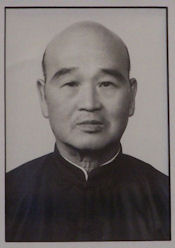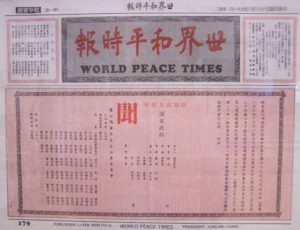History of the Martial Arts at the Tai Chi Center
At the request of Grand Master Lu Hung Bin, Iva Lim Peck and Richard A. Peck founded the Tai Chi Center in 1986. The primary purpose of the Center is to carry on the tradition of Grand Master Lu Hung Bin and pass on those teachings of Taiji Quan (Tai Chi Chuan), Ba Gua Zhang (Pa Kua Chang), and Xing Yi Quan (Hsing-Yi Chuan).
Grand Master Lu Hung Bin (Lu Shu Kui)

Lu Hung Bin (Lu Shu Kui) (also spelled Lu Hongbin) was born in Wen Du village in mainland China. As a young boy he was introduced to martial arts by his grandmother and father. His grandmother, who was schooled in martial arts, taught him strength building exercises. These exercises were to be the foundation for his development in the martial arts. He learned Ba Gua Zhang from Cheng Hai Ting (Cheng Yu Lueng). Cheng was the son of the famous Ba Gua Zhang Master Cheng Ting Hua, who was a direct student of the founder of Ba Gua Zhang, Tong Hai Chuan. In the late 1940’s he left mainland China and went to Taiwan. His name appears on the grave stone of Tong Hai Chuan in the lineage of Ba Gua Zhang practitioners.
Shortly after Richard and Iva Peck founded the Tai Chi Center in Garland, TX (Dallas Metroplex area), Lu Hung Bin came to live with them and taught at the Tai Chi Center. At this point Lu shared on a continuous basis his in-depth knowledge of Chinese martial arts. Lu lived with Iva and Richard and continued to teach them not only the physical aspects of martial arts but also the underlying philosophical aspects. Lu passed away in the summer of 1990. Prior to his death he instructed his family that at his passing the names of his top students were to be published in the local Taipei newspaper. Iva and Richard and their martial art brother Kent Williamson from Sweden are the only foreign students honored to carry on the tradition of his martial arts. Their names appear along with his Chinese students.
Taiji Quan (Tai Chi Chuan)
There are many legends as to who first developed the art of Taiji Quan (Tai Chi Chuan). As with most legends, there is an element of truth and a lot of fiction. One of the most accepted theories as to the origin of this art attributes its beginning to Chang San Fang a Taoist monk who had a background in Shaolin martial arts. One day in the 13th century he saw an altercation between a snake and a crane. Watching the struggle between the two animals he noticed that it was not a battle of strength but a dissolving of the attack that seemed to be the predominant method of defense. We don’t know who won the altercation but we do know that this experience of watching the struggle had a profound effect on the development of this art. Today there are movements within the Taiji Quan called Snake Creeps Down and White Crane Spreading its Wings that reflect this art. Taiji Quan started as a martial art and developed into a very effective means of self defense. Within the recorded history, the Chen family in mainland China took the rudimentary movements of Taiji Quan and developed it into the art as we know it today.
Up until the 18th century the Chen family would not teach the art to anyone outside of the family. In the 18th century Yang Lu Chang, who was a servant within the family, surreptitiously learned the art by watching through a hole in the wall. What he saw he practiced. Once he had learned the art he left the family and went to Beijing. He softened the original moves and changed them to suit his ability and then taught anyone who wanted to learn. The art finally became public. Taiji Quan has gone through a number of modifications since it was taken from the Chen family. Today we still have the Chen Style Taiji Quan. In addition we have Yang Style, named after Yang Lu Chang, Wu Style, Hao Style, Sun Style and many other variations.
The movements of Taiji Quan are soft and fluid and follow the concepts of Yin and Yang. Most people study Taiji Quan for its graceful and beautiful movements. It resembles a slow dance and is sometimes referred to as land swimming or shadow boxing. The art is taught in many schools of dance because practice of the movements enhances one’s balance. Many students have no interest in the martial art capabilities of the art. It is one of the best exercises for those suffering from arthritis, hypertension, stress related illnesses, degenerative diseases, etc. It can be practiced by anyone, male or female, young or old, short or tall, coordinated or uncoordinated. It is not so important which style of Taiji Quan you study; however, it is important to study from a competent teacher that has at the very least four years of experience. All the instructors at the Integrated Center for Oriental Medicine (Tai Chi Center) have the necessary experience to teach classes. The Taiji Quan program at the center is one of the most well rounded and comprehensive programs in the southwest United States.
Ba Gua Zhang (Pa Kua Chang)
Ba Gua Zhang is a rather recent creation. Historical records indicate that the founder of this art is Tong Hai Chuan (1796-1880). His grave site is located outside of Beijing. Engraved into the large grave stones is a list of his top students and the lineage of succeeding generations of practitioners. Our teacher Grandmaster Lu Hung Bin appears on this list as the fourth generation of practitioners, which makes us the fifth generation of Ba Gua Zhang practitioners. Even though there are historical records about Tong Hai Chuan, there is no clear cut explanation as to whether he created this art himself or learned it from someone else. One story attributes his learning of this art to an old Taoist monk who lived on a mountain and taught it to him over a period of time. Such stories while interesting to read are often created to add mysticism to the development of the art.
Taiji Quan is characterized by its soft movements that go corner to corner, back and forth, and are circular. Ba Gua Zhang enhances this circularity with the circular movements of this martial art done while walking a circle. In essence there is circularity of movement within a circle. The movements of Ba Gua Zhang are more demanding than Taiji Quan and there is a definite emphasis placed on the martial arts aspect of the art. It is the perfect art to be learned by those already familiar with other martial arts. Major stress is placed on balance and postural alignment to enhance ones internal energy. It is a very close-in fighting art that utilizes joint locks, throws and take-down techniques. All the techniques are centered around the ability to turn and coil the waist to develop internal energy. Open palm techniques are favored over closed fist techniques.
Xing Yi Quan (Hsing-Yi Chuan)
Xing Yi Quan translates as Mind-Body Boxing. It was initially conceived by General Yeuh Fei (1103-1142) as a method of training his troops for battle. He was legendary in military annals as a superior commander of troops defending the country. The basic movements of Xing Yi Quan consists of five fist forms referred to as the Five Elements. The five elements are metal, water, wood, fire and earth and correspond to the Five Element theory in different aspects of Chinese culture including Chinese medicine (acupuncture and herbology).
Each one of the fists influence one of the other fists and can be used in sequence in an altercation. The basic development of Xing Yi Quan was the five fists forms. The five fists are incorporated into animal styles that mimic the movements and energy of specific animals. Usually there are twelve animals represented in the complete system along with a linking form to help the student understand the principles of the art. Xing Yi Quan is rather simple in its structure, but the simplicity of the movements allows for the development of its tremendous power.
Qi Gong (Chi Kung)
Qi Gong, which is the cultivation of internal energy, goes back thousands of years in Chinese history. It predates Taiji Quan, Ba Gua Zhang and Xing Yi Quan; however, its concepts in one form or another are used in all three of these arts. There are many different styles of Qi Gong. Practiced on a regular basis, Qi Gong will have a profound effect on the physical, mental and spiritual development of anyone regardless of their age. The movements are more static than martial arts. Often one posture will be held for an extended period of time to build up the internal energy. It is easy to learn but the underlying philosophy and cultivation of the Qi (internal energy) is continually developed over a lifetime. Those that practice Qi Gong have less stress, lower blood pressure, and a greater sense of well-being.



